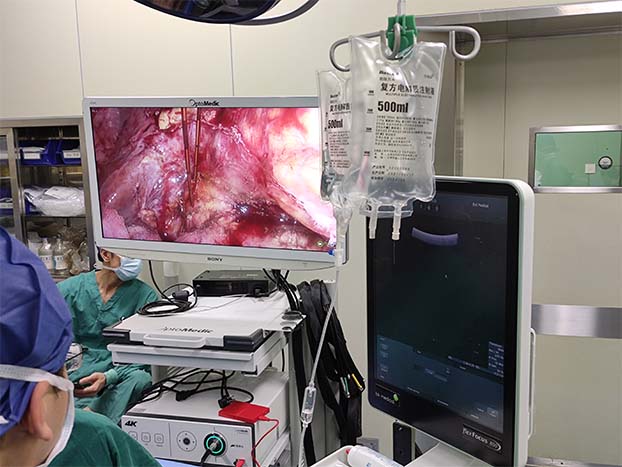

The patient is a 56-year-old female who underwent radical surgery for gallbladder cancer in September 2021 and 8 cycles of postoperative chemotherapy. on review on April 8, 2022, imaging revealed soft tissue density shadow in the area of hepatoportal hepatic duct-proximal common bile duct walk, and soft tissue shadow along the area of hepatoportal bile duct convergence-proximal common bile duct walk. enhancement showed enhancement with an extent of about 25mm*18mm*42mm (cross-sectional diameter*inferior and superior diameter) The intrahepatic bile duct is dilated. Tumor recurrence was considered.
The recurrent lesion is growing along the remaining common bile duct towards the intrahepatic bile duct and there is a cancer thrombus in the bile duct next to the cancer. If conventional temperature ablation procedure is used, it will cause irreversible damage to the bile duct and the risk is high.
After the consultation with the patient, Director Wan Chidan of the Department of Hepatobiliary Surgery said, "Nano knife technology can selectively destroy the stability of tumor cell membranes and cause apoptosis of tumor cells without damaging the bile ducts and large blood vessels in the hepatoportal area, and can relieve the symptoms of biliary obstruction as the tumor shrinks, while the bile ducts and surrounding vascular structures can be restored and preserved, which is a new treatment method.
On April 13, under the leadership of Director Wan Chidan, Professor Xiong Jun successfully completed the laparoscopic ablation of the patient's Nanoknife. The operation was performed with the "Domestic Nanoknife", a steep pulse minimally invasive treatment system developed and manufactured by Shanghai Yuanshan Medical Technology Co.,Ltd.


Preoperative MRI

"The precise placement of electrode needles is the key to the success or failure of the operation, as the electrode ablation needles should be kept parallel as much as possible, and the lesion should be completely included in the electric field in order to get the best treatment effect. According to the imaging data and laparoscopic investigation, Prof. Xiong Jun designed the needle path, and skillfully performed percutaneous puncture, placed double needles to wrap the lesion, and carried out ablation.

Laparoscopic-guided needle ablation.
Prof. Xiong Jun said after the operation, "This operation has proved that trans-laparoscopic guided Nanoknife ablation is a minimally invasive, safe and efficient tumor treatment technology, and it is believed that the domestic Nanoknife will have a broader clinical application prospect in the near future to benefit more patients. For the cases of this operation, in addition to the close observation during the patient's hospitalization, we will also do the return visit of the efficacy in the middle and late stages.
Nanoknife in liver malignant tumor ablation
5 areas commonly used
1、First hepatic hilar
2、Second hepatic hilar
3、Gallbladder area
4、Caudate lobe of the liver
5、Liminal region of the liver adjacent to the intestinal canal

|
Wan Chidan Chief Physician / Professor / Doctoral Supervisor Director of Hepatobiliary Surgery, Union Hospital of Huazhong University of Science and Technology - Member of the Splenic and Portal Hypertension Group of the Chinese Society of Medical Surgery - Member of Hepatocellular Carcinoma Committee of Chinese Physicians Association - Member of Living Organ Transplantation Committee, Chinese Physicians Association, Organ Transplantation Physicians Branch - Member of the Medical Robotics Committee of the Chinese Medical Association - Deputy Director of the Medical Robotics Committee of the Chinese Society of Automation - Member of the Committee on Development and Promotion of Laparoscopic Liver Resection in China - Standing Committee Member of the General Surgery Committee of the Chinese and Western Medicine Association - Standing member of the Digital Intelligent Surgery Committee of the Chinese Society of Research Hospitals - Member of the Hepatocellular Carcinoma Group of the Hepatobiliary and Pancreatic Specialty Committee of the Chinese Society of Research Hospitals - Member of the Standing Committee of ERAS of Hepatobiliary and Pancreatic Surgery, International Hepatobiliary and Pancreatic Association, China Branch - Standing Committee Member of Liver Transplantation Branch of China Association for the Promotion of International Exchange in Health Care - Director of the General Surgery Committee of the Hubei Association of Integrative Medicine - Vice Chairman of the Hubei Liver Committee of the Chinese Anti-Cancer Association - Member of Hubei Medical Association General Surgery Branch - Member of Hubei Provincial Medical Association Organ Transplantation Branch Editorial board member of Chinese Hepatobiliary Surgery, Current Medical Science, Organ Transplantation, Abdominal Surgery, etc. He has been engaged in general surgery clinical and research work for more than 20 years, and has accumulated rich experience in diagnosis and minimally invasive surgery of hepatobiliary diseases, liver transplantation surgery and management. In liver transplantation, he routinely performs a variety of liver transplantation procedures, including DCD liver transplantation, pediatric liver transplantation and living relatives liver transplantation, with remarkable treatment results. In addition, he has conducted in-depth exploration in minimally invasive surgery for liver and cirrhotic portal hypertension, and was the first to complete the fully laparoscopic ALPPS (two-step liver resection method of portal vein ligation combined with liver separation) for previously unresectable liver cancer in the central and southern regions; the first to apply Chen's technique to laparoscopic and robotic arm-assisted liver resection; the first to propose the Wuhan Union ablation treatment method for giant hemangioma of the liver; the first to propose He was the first to propose the "tunnel method" of laparoscopic splenectomy + peripancreatic vascular dissection, with satisfactory results in the near and long term; he routinely performs all kinds of hepatobiliary and pancreatic surgery with the assistance of laparoscopy and robotic arm. |

|
Xiong Jun 主任医师 华中科技大学附属协和医院肝胆外科 · 中国医师协会器官移植分会移植免疫专业委员会委员; · 中国抗癌协会肿瘤微创治疗专业委员会肿瘤外科微创专家委员会常务委员; · 国际肝胆胰协会中国分会转移性肝癌专业委员会委员; · 中国研究型医院肝病专业委员会肝癌学组委员; · 中国研究型医院加速康复外科委员会肝脏学组委员; · 中国研究型医院加速康复外科委员会肝移植学组委员; · 中国医疗保健国际交流促进会肝脏移植分会代谢管理学组委员; · 湖北省抗癌协会肝癌专业委员会常务委员; · 武汉医学会器官移植分会委员; · 武汉医学会第一届医疗损伤鉴定专家; · 近年致力于以外科手术(消融、肝切除、肝移植)等为主的原发性肝癌、转移性肝癌、肝血管瘤等序贯性治疗;其中完成腹腔镜超声引导下消融治疗肝肿瘤,已完成1700余例。 |